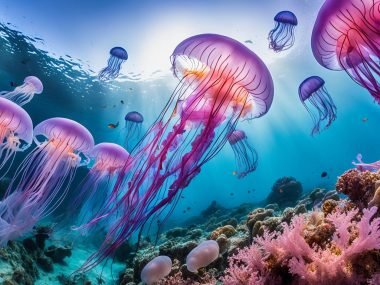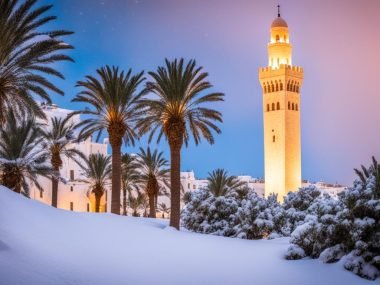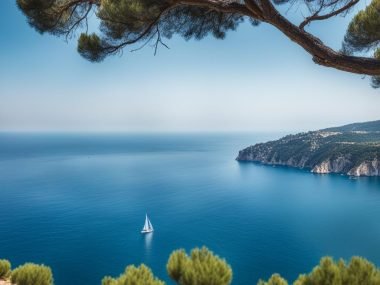Did you know nearly 25% of Tunisia is covered by the Sahara Desert? This country is in Northern Africa. It has lots of different types of places. In the north, there are green, mountainous areas with the Medjerda River. But in the south, it’s mainly the big, dry Sahara Desert. Tunisia has a long coast by the Mediterranean Sea and also touches the desert. This mix of sea and desert makes Tunisia’s land very special.
Key Takeaways
- Tunisia lies in Northern Africa, bordered by the Mediterranean Sea to the north.
- The country shares borders with Algeria to the west and Libya to the southeast.
- Tunisia covers an area of 163,610 square kilometres, with diverse geographical regions.
- The southern regions of Tunisia are significantly influenced by the Sahara Desert.
- Iconic Saharan landmarks such as Chott el Djerid underline the desert’s presence in Tunisia.
Understanding Tunisia’s Geography
Tunisia’s geography is both beautiful and varied. It has different landscapes and climates. Its position by the Mediterranean Sea and near the Sahara Desert makes it special. This mix shapes the country’s areas.
Location and Size
Tunisia lies along the Mediterranean in North Africa. It’s about as big as the state of Wisconsin. It has a mix of beautiful landscapes. From the north’s coastal plains to its green rolling hills like the Tell.
Heading south, the scene shifts. It turns into dry steppes that meet the Sahara Desert. This shows how the land drastically changes.
Environmental Diversity
Tunisia’s diverse environment comes from the Dorsal mountains. These mountains cut the country in half. They separate the green north from the dry south. Tunisia has many landscapes – from coastal plains and green hills to dry lands and the Sahara. This variety is home to different living things. It shows how Tunisia can adapt to various weather.
Here’s a table that explains Tunisia’s main geographical parts. It makes things simple:
| Geographical Feature | Location | Characteristics |
|---|---|---|
| Coastal Plains | North | Fertile, Mediterranean climate |
| Rolling Hills and Tell | North-Central | Verdant, agricultural productivity |
| Sparse Steppes | Central | Transitional zone, semi-arid |
| Saharan Desert Region | South | Arid, dramatic landscapes, part of the expansive Sahara |
Tunisia’s Climate Zones
Tunisia has different weather patterns from north to south. This makes the country special.
Northern Coastal Climate
The north of Tunisia gets its weather from the Mediterranean Sea. It has a Mediterranean climate. Winters are mild and wet. Summers are hot and dry.
Coastal breezes make the weather nice all year. This weather is good for farming. It helps grow olives, citrus, and other crops.

Southern Desert Climate
The south of Tunisia is very dry because of the Sahara Desert. Summers are very hot. Winters are moderate but with little rain.
This leads to large deserts and salt flats, like Chott el Djerid. The south is known for its dry weather and big temperature changes from day to night.
| Climate Zone | Typical Weather | Prominent Features |
|---|---|---|
| North | Mild, wet winters Hot, dry summers |
Mediterranean influence Agricultural fertility |
| South | Extremely hot summers Moderate winters Scarce precipitation |
Desert landscapes Salt flats |
Tunisia’s climate varies a lot, from green north to dry south. This difference shapes the country’s environment and how people live and work.
Boundary Definitions of the Sahara Desert
The Sahara Desert is vast, covering 9,200,000 square kilometres. It’s the biggest hot desert in the world. It’s found in the north of Africa. We see how nature and climate shape its edges.
Geographical Extent
The Sahara spreads wide, from the Atlantic Ocean to the Red Sea. And from the Mediterranean Sea down to the Sahel. It covers 11 countries like Algeria and Egypt.
These countries show the desert’s varied geography. They add to the desert’s diverse landscape.
Countries within the Sahara
It’s key to understand the Sahara’s countries. Each one has a unique desert geography. The desert’s southern border is next to the Sahel.
The Earth’s tilt changes the desert’s size over time. It also changes the weather and dry areas in these lands.
Sahara Desert Facts and Figures
The Sahara Desert is huge, stretching over 3,600,000 square miles. It is full of different kinds of places. Under the hot sun, it has everything from large sandy areas to rocky formations.

Area and Dimensions
The Sahara Desert is the biggest hot desert in the world. It covers big parts of Northern Africa. It’s so large, it leads many talks about deserts. The desert holds many interesting spots, like large empty areas and lively water spots.
Types of Terrain
Talking about the Sahara means talking about its varied land. Most of it has rock fields called hamada. These provide a shocking difference to the large sand areas or ergs that take up about 20% of the Sahara. These sand dunes are big and change shape with the wind. There are also dry valleys and special rock forms, like the Richat Structure or the “Eye of the Sahara”.
| Type of Terrain | Features |
|---|---|
| Rocky Hamada | Stone plateaus, minimal sand, exposed rock surfaces |
| Ergs | Vast sand dunes, wind sculpted, dynamic landscapes |
| Arid Valleys | Dry river beds, occasional oases, sparse vegetation |
| Richat Structure | Geological formation, circular pattern, also known as “Eye of the Sahara” |
In this huge desert, the Tibesti Mountains and Emi Koussi peak stand tall. They are interesting spots that add variety to the large flat desert.
Is Tunisia In The Sahara Desert?
The southern edge of Tunisia blends into the Sahara. This shows its special place on the map. The fact that a big part of Tunisia is in the world’s biggest hot desert is important.
This tells us about the southern areas of Tunisia. They have their own climate and different kinds of land because of this.
Going south through Tunisia, we see the Sahara’s dry lands. Being close to the Sahara changes the land, the jobs people do, and their traditions. So, Tunisia is a key spot in the Sahara with a mix of nature and life.
| Region | Characteristics |
|---|---|
| Southern Tunisia | Integration with the Sahara Desert |
| Saharan Landmass | Expansive desert terrains |
| Environmental Impact | Distinctive climatic conditions |
The Tunisian Sahara Region
The Tunisian Sahara is both naturally beautiful and full of history. It’s known for its vast lands and special sceneries. This place attracts many people, from explorers to movie makers. Let’s look at what makes this part of Tunisia so special.
Main Features
Chott el Djerid is a big salt lake in the Sahara. It’s famous in Africa. This lake looks like something from another world. It shines and brings people to see it. The area has both huge sand dunes and stone plateaus. These features are a sharp change from Tunisia’s coastal areas.
Notable Locations
Some spots in the Tunisian Sahara are well-known around the world. Matmata is famous for its ancient Berber houses. These houses are built under the ground. Chebika is a lovely oasis in the mountains. It has palm trees and springs.
Star Wars fans would love Mos Espa and Lars Homestead. These places were used for filming the movies. They show the beauty of this region. They also highlight its cultural importance and role in films.
Exploring Tunisia’s Southern Desert
Tunisia’s Southern Desert offers amazing experiences and deep cultural value. It captures the Sahara’s charm, offering fun activities and historical insights.
Tourist Activities
Tunisia’s southern Sahara is perfect for adventure and culture lovers. Enjoy sandboarding on golden dunes or calm camel rides. There’s something for everyone.
Douz, the ‘Gateway to the Sahara,’ has exciting annual festivals. These celebrate the desert culture with fun and tradition.
- Sandboarding
- Camel Trekking
- Guided Cultural Tours
- Desert Festivals
- Stargazing
Cultural Significance
The Sahara’s cultural importance in Tunisia is huge. It acts like a living history book of Saharan life. Visiting Nefta and Douz, you see natural beauty mixed with culture.
These places also tell stories of human strength and creativity.
Through music, crafts, and storytelling, the Sahara’s culture shines. Exploring these, we learn and value Tunisia’s Sahara and its tourism charm.
Impact of the Sahara on Tunisia’s Climate and Ecosystem
The Sahara Desert changes Tunisia’s climate a lot, especially in the south. It’s really hot in summer and cooler in winter there. These big changes show what desert weather is like. It makes the southern part of Tunisia very dry.
Temperature Variations
The Sahara makes Tunisia’s climate go up and down. In the south, summers get super hot, over 40°C. But winters are cooler and dry. This means people and businesses must adjust to these changes.
Biodiversity and Vegetation
The Sahara Desert helps nature in Tunisia in a special way. Even with little water, many plants and animals live there. Plants that can live without much water, like acacias and date palms, do well. Animals like the fennec fox and different reptiles live there too. This shows how nature can adapt to tough places like the Tunisian Sahara.







